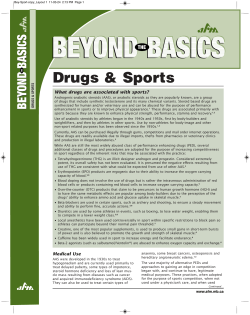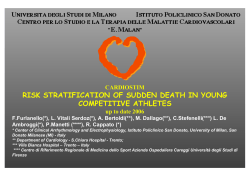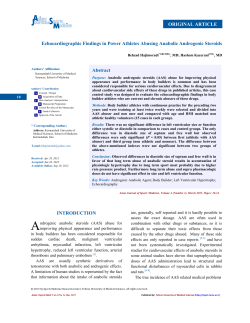
Sports Medicine: Performance-Enhancing Drugs Andrew J.M. Gregory, MD, FAAP, FACSM ,
Pediatr Clin N Am 54 (2007) 797–806 Sports Medicine: Performance-Enhancing Drugs Andrew J.M. Gregory, MD, FAAP, FACSMa,b,*, Robert W. Fitch, MDa,b a Vanderbilt University Medical Center, MCE–South Tower, Suite 3200, Nashville, TN 37232, USA b Vanderbilt University, MCE–South Tower, Suite 3200, Nashville, TN 37232, USA Primary Care Sports Medicine has evolved as a field because of the need for physicians who are able to take care of the whole athlete and not just their orthopedic needs. This includes medical problems (eg, exercise-induced asthma or concussion), mental disorders (eg, eating disorders or anxiety), as well as an understanding of how medications affect training and exercise. To protect the athlete, physicians who take care of athletes need to be able to educate coaches, parents, and athletes about the benefits and risks of performance-enhancing drugs from a scientific perspective. First, physicians must educate themselves regarding performanceenhancing drugs because this is not a subject taught in medical school or residency; however, we also must be cautioned not to contribute to the problem because, historically, many physicians have been the ones providing these drugs to the athletes (eg, steroids for Olympic programs in East Germany or blood doping in the Tour de France). Regardless, if we are employed by the team or acting voluntarily, the team physician must keep the best interests of the athlete above everything else. Performance-enhancing drugs, ergogenic aids, or sports supplements have been a part of sports since sporting competition began and likely always will be. Considered cheating by purists and necessary by some athletes, we must accept the fact that they are used, understand why they are used, and study how to prevent their use to institute change. This article summarizes current scientific information regarding the use of performance- * Corresponding author. Vanderbilt Sports Medicine Center, MCEdSouth Tower, Suite 3200, Nashville, TN 37232. E-mail address: andrew.gregory@vanderbilt.edu (A.J.M. Gregory). 0031-3955/07/$ - see front matter Ó 2007 Elsevier Inc. All rights reserved. doi:10.1016/j.pcl.2007.07.001 pediatric.theclinics.com 798 GREGORY & FITCH enhancing drugs in young athletes so that physicians can take the information and knowledgably educate others. For this discussion, a drug refers to any substance that exerts an effect on a body system, and a supplement refers to a substance that is taken to augment the diet. Most vitamins and minerals are benign in nature and are difficult to misuse; however, some supplements (stimulants, steroid precursors) clearly are drugs and have the potential to cause significant morbidity and death. The categorization of these more significant substances with the more safe ones leads people to think that all supplements are safe; therefore, they are taken without consideration of harmful effects. There are many different drugs and supplements used by athletes to enhance performance. Some of the more common classes are blood doping, anabolic steroids, stimulants, growth hormones, amino acids, and proteins [1]. Several of these productsdalthough initially believed to be ineffectived have been shown to be good at increasing strength, decreasing fatigue, and building muscle. Although some of these products are illegal, they are readily available through prescription, supplements, local gyms, and the Internet (mostly from Mexico). Because dietary supplements are treated differently than drugs by the US Government, supplement manufacturers do not have the same production standards as drug manufacturers. Supplement dilution or contamination is common as the same containers are used to process multiple different supplements without cleaning out the residue from the first. US Pharmacopeia and Consumer Labs perform purity testing and publish results on the different products from supplement manufacturers. The US Food and Drug Administration (FDA) is responsible under the Federal Food, Drug, and Cosmetic (FD&C) Act for ensuring that manufacturers of foods, including dietary supplements, provide safe ingredients for their products as well as accurate, complete labeling that is truthful and not misleading [2]. Dietary supplements are treated as foods, as long as no drug claims are made for them. When products are marketed for therapeutic use, FDA regulates them through its Center for Drug Evaluation and Research. The Nutrition Labeling and Education Act of 1990 (NLEA) [3], which amended the FD&C Act, provides the FDA with specific authority to require nutrition labeling of most foods and to require that all nutrient content claims and health claims be consistent with agency regulations. This drew the attention of supplement companies who were concerned that the FDA would now have additional authority over dietary supplements. They lobbied that the FDA would now be choosing for consumers what they could and could not have. The Dietary Supplement Health and Education Act (DSHEA) of 1994 [4], which amended the NLEA, limits the FDA’s authority by imposing a more relaxed standard for claims on supplements than for conventional foods. It defines a dietary supplement as a product intended to supplement the diet that contains one of the following ingredients: vitamin, mineral, herb or other SPORTS MEDICINE: PERFORMANCE-ENHANCING DRUGS 799 botanical, amino acid or a concentrate, metabolite, constituent, extract, or combination of any ingredient. The Act shifts the burden of proof of safety from the manufacturer to the FDA. The Act also permits health claims if they accurately represent the current state of scientific evidence concerning the relationship between the supplement and a disease or other health-related condition, a determination that is left to the manufacturer. Since the DSHEA of 1994, the FDA has proven several ingredients to be harmful and, therefore, required that they be removed from dietary supplements. Ephedra (ephedrine alkaloids) was the first to be banned in 2004 because of concerns over its cardiovascular effects, including increased blood pressure, irregular heart rhythms, and death. Also, in 2004, the Anabolic Steroid Control Act [5,6] was passed in the US Congress. It amends the Controlled Substances and Anabolic Steroids Control Acts to clarify the definition of anabolic steroids and to provide for research and education activities relating to steroids and steroid precursors. In addition to adding steroid precursors to the controlled substances list, it increased penalties for anabolic steroid offenses near sports facilities. The most recent Act is the 2006 Dietary Supplement and Nonprescription Drug Consumer Protection Act, which mandates manufacturers of supplements and over-the-counter products to report serious adverse events to the FDA within 2 weeks of the claim. Manufacturer contact information is now required on the label, and all records of claims must be kept on file. It is hoped that these recent changes will protect the athletes from potential adverse events from products sold in supplements. Although the Drug Enforcement Agency historically has concentrated on street drugs, in 2002 they began prosecuting manufacturers, distributors, and consumers of anabolic steroids. Victor Conte, who was the founder of BALCO Labs in San Francisco and the manufacturer of THG (tetrahydragestrinone), was arrested in 2004. Albert Saltiel-Cohen, a Mexico City veterinarian and owner of three of the largest steroid-manufacturing companies in the world, was arrested in 2005 in San Diego. In 2007, the owners of Signature Pharmacies in Orlando, Florida were arrested for fraudulently prescribing steroids and human growth hormone over the Internet. Given the fact that young athletes use supplements and steroids, it behooves us to review what exactly they are using and why. There are few studies on side effectsdespecially long-termdand none at all in children. Most adolescent athletes do not make the most of their diet for performance before considering supplements. Most public high schools do not have drugtesting programs and are not likely to have them because of the cost. We are not sure that testing is an effective deterrent to use, but we do know that education works. A 2003 survey showed that high school athletes frequently use supplements, including sports drinks, vitamin and minerals, energy drinks, herbal supplements, guarana, creatine, protein, and coenzyme Q10 [7]. They reported that they use them because of perceived short-term health benefits, 800 GREGORY & FITCH prevention of illness, improved immunity, parental supply, taste, energy boost, better sports performance, and to rectify a poor diet. In 15,000 adolescents from the 2006 National Longitudinal Study of Adolescent Health, boys were more likely than were girls to use anabolic steroids and legal supplements [8]. High school sports participation was associated with an increased likelihood that adolescents would use legal supplements in young adulthood. There was also a positive relationship between the use of legal dietary supplements and anabolic steroid use. In a 2006 study of high school athletes in Nebraska, one quarter reported currently taking supplements [9]. Sports performance was the most reported reason for use, and their coach was listed as their best source of information on supplements. An anonymous survey of football and volleyball players from 20 high schools in northwest Iowa in 2001 showed that 8% of the male athletes and 2% of the female athletes were using supplements [10]. These included creatine, androstenedione, beta-hydroxy beta-methylbutyrate, amino acids, dehydroepiandrosterone, Phosphogen, Weight Gainer 1850, Tribulus, Muscle Plus, multivitamins, calcium, Gamma-aminobutyric acid, Shaklee Vita Lea, and Physique. A survey of national track and field athletes competing at the 2004 World Junior Championships reported that 62% of respondents used supplements [11]. Of those, use among female athletes (75%) was higher than among male athletes (55%). Seventeen different supplements were reported, with an average of 2.5 products each (mostly multivitamins and minerals). Persons with the most influence on practices included coaches (65%), sports dieticians (30%), and doctors (25%). In 1994, a questionnaire administered to all athletes at nine high schools in one rural county in Minnesota showed that 38% used supplements, equally by gender and grade in school [12]. Athletes with aspirations to participate in college sports were more likely to consume supplements. Healthy growth, treating illness, and sports performance were the most important reasons reported for supplement use. Parents, doctors, and coaches were reported as being the greatest influences on use. Most athletes believed that supplement consumption improved athletic performance. In 1995, the Nutritional Supplement Use and Knowledge Scale found that greater knowledge about supplements was associated with less use [13]. Protein supplements often are used by athletes with the hopes of adding muscle or repairing muscle damage from workouts. They are sold as powders to be used in shakes and taken directly before or after a workout. Most Americans consume the recommended daily allowance for protein each day. Unless the athlete is vegetarian and does not get protein from another source, supplementation is not indicated or necessary for building muscle. Although protein supplementation seems to be safe, if taken at the doses recommended, a significant protein load is placed on the kidneys. If this occurs during a period of dehydration, such as in a particularly intense workout in hot or humid conditions, the kidneys are at risk for acute failure. SPORTS MEDICINE: PERFORMANCE-ENHANCING DRUGS 801 Creatine probably is the protein supplement that is used most commonly by athletes for increasing strength [14]. It was discovered in the 1920s and made popular by Mark McGwire in Major League Baseball in the 1990s. It is a protein that is stored in skeletal muscle that binds phosphate to serve as an energy substrate for ATP. Creatine has demonstrated improved performance in repeated bouts of high-intensity strength work and sprints. There are no demonstrated effects in single-sprint activities, endurance exercise, or competition. Therefore, it is useful for increasing training intensity and volume to enhance physiologic adaptation. One to 2 g of creatine per day are synthesized in the kidney, liver, and pancreas from the essential amino acids arginine, glycine, and methionine. An additional 1 to 2 g/d are obtained from a meat-containing diet. Once the muscle stores are saturated, the remaining creatine is converted to creatinine and cleared by the kidneys. Creatine is sold in a powder or liquid form in recommended dosages sometimes greater than 10 g/d. Taking dosages greater than 2 g/d is unnecessary and potentially harmful to the kidneys. There are two case reports of worsening renal failure in children who had underlying kidney disease using creatine. Other reported side effects include weight gain (water weight), nausea, and muscle cramping. Overall, creatine seems to be safe in adults, but no study has been performed specifically in children. In 2000, students aged 14 to 18 years were surveyed regarding creatine during their preparticipation screen at a single institutional sports medicine center in Minnesota [15]; 8.2% of athletes reported creatine use, and half were taking creatine at the time of the survey. Most users believed creatine improved their performance and did not know how much creatine they were taking or were taking greater than the recommended dosage. They were more likely to know other creatine users and to use other supplements. Most obtained information from friends and purchased it from health food stores. In 2001, athletes from 37 public high schools in Wisconsin took part in a cross-sectional, multisite, anonymous, descriptive survey of creatine use [16]; 16.7% of the athletes (25.3% boys, 3.9% girls) reported using creatine, from 8% in the 9th grade to 25% in the 12th grade. The sport with the lowest use was female cross country (1%), and football was the sport with the highest use (30%). For football, use differed by grade: 10.4% of grade 9 athletes and 50.5% of grade 12 athletes reported using creatine [17]. School size was inversely proportional to use, with 41% of players at small schools and 29% of players at large schools reporting use. Increased strength was the most likely perceived benefit, whereas dehydration was cited most often as a perceived risk. Users were encouraged to use most often by their friends, whereas their parents discouraged its use. In 2001, 1103 middle and high school athletes aged 10 to 18 years in Westchester County, New York were surveyed before their preparticipation screen [18]. Six percent of athletes admitted taking creatine in all grades (6–12), but the highest use was found among the twelfth-grade students (44%). Use was higher in boys (9%) than in girls (2%) and was more 802 GREGORY & FITCH common in football, wrestling, hockey, gymnastics, and lacrosse. Users reported enhanced performance and improved appearance as the most common reasons for use. Safety was cited as the most common reason for not using. Androgenic-anabolic steroids (AASs) are perhaps the best known and most widely publicized of the performance-enhancing drugs. Shown to be effective by the East German Olympic athletes in the 1950s, steroids are known to permeate the sports of weight lifting, body building, professional wrestling, and the Olympics. Anabolic steroids include derivatives and precursors of the hormone testosterone. Testosterone exerts many effects on the body, including increasing protein synthesis and euphoria and decreasing catabolism. Initially, the medical community demonstrated that steroids were not effective, but the tests were conducted using physiologic dosing instead of what the athletes were using (10–100 times that). There is no doubt now that steroids work; however, the potential side effects are significant and must be taught to athletes. These include decreased testosterone production, testicular atrophy, and gynecomastia in boys and masculinization in girls. Cardiovascular effects are substantial, with clotting, myocardial infarction, stroke, and death topping the list. If the injectable form is used, aside from disease transmission risks, hepatitis, cholestasis, and even, carcinoma can form in the liver. Psychologic effects are common, including aggression, dependence, anxiety, depression, and psychosis. In adolescents, early epiphyseal closure and increased suicidal ideation and attempts have been described. Mood swings and irritability may be clues to anabolic steroid use as well as drug abuse. A 2000 systematic review showed that adolescent anabolic steroid users were significantly more likely to be boys and to use other illicit drugs, alcohol, and tobacco. It also showed that student athletes were more likely than were nonathletes to use steroids. Football players, wrestlers, weightlifters, and bodybuilders had significantly higher prevalence rates. In 2002, the Project EAT: Eating Among Teens study was performed on 4746 middle and high school students from St. Paul/Minneapolis public schools. They completed surveys and anthropometric measurements regarding eating patterns and weight concerns. Reported steroid use was 5.4% in boys versus 2.9% in girls. In boys, AAS use was associated with poorer selfesteem, depressed mood, attempted suicide, poorer knowledge and attitudes about health, greater participation in sports that emphasize weight and shape, greater parental concern about weight, disordered eating, and substance use. Among girls, steroid use was less consistent in its associations with other variables. In 1999, varsity football players in Indiana were selected randomly from 27 high schools to complete a questionnaire. Out of 873 subjects, 6.3% were current or former AAS users. The average age at time of first use was 14 years, but 15% began taking before the age of 10 years. Half of the respondents indicated that they could obtain AASs if they so desired. Other athletes, physicians, and coaches were listed as sources for AASs. SPORTS MEDICINE: PERFORMANCE-ENHANCING DRUGS 803 In 1998, a confidential self-report questionnaire was administered to male and female students, 9 to 13 years of age, from four public middle schools in Massachusetts. The response rate was 82% (965/1175 eligible), and 2.7% of all middle school students reported using steroids (boys and girls). More steroid users than nonusers believed that steroids make muscles bigger and stronger, improve athletic performance, make one look better, were not bad for them, knew someone their own age who currently took steroids, were asked by someone to take steroids, and reported that they would take steroids in the future. In 2006, 2924 Norwegian high school students (age 15–19 years) were surveyed at 5-year intervals; 1.9% reported the use of AASs in 1994 and 0.8% reported their use in 1999. By multivariate logistic regression, future AAS use was predicted by young age, male gender, previous AAS use, power sports participation, and frequent alcohol use. The 1997 Centers for Disease Control and Prevention Youth Risk Behavior Surveillance was a nationally representative sample of more than 16,000 United States public and private high school students; 6.1% of students in high school had taken illegal anabolic steroids. Binge drinking, cocaine use, fighting, and sexual risk-taking were associated with higher odds of lifetime steroid use. Neither athletic participation nor strength conditioning predicted the odds of steroid use after controlling for problem behaviors. Steroid-using athletes reported the same frequency of use as did steroidusing nonathletes. Stimulants may be the most widely and underrecognized supplement used by high school athletes and yet are the least studied. Common stimulants include caffeine (guarana [Paullinea cupana]), ephedrine (ephedra or ma huang), pseudoephedrine, Neo-Synephrine, amphetamines, and methamphetamines. Stimulants can be found in coffee, colas, energy drinks, cough and cold medications, muscle building or weight loss supplements, attention-deficit/hyperactivity disorder (ADHD) medication, and diet pills. Most studies on stimulant use are with medication used to treat ADHD and not on use with athletics. There are a few studies on their use for athletic performance in adults, but no studies have been done in the young. Stimulants act on the central nervous system (CNS) to increase arousal, respiratory rate, heart rate, and blood pressure and, therefore, improve performance. Side effects can include dizziness, insomnia, agitation and restlessness, anxiety, confusion, paranoia, hallucinations, dyskinesias, gastrointestinal disturbances, heat intolerance, stroke, myocardial infarction, arrhythmia, and death. Severe rebound of fatigue and depression occurs after discontinuance. Contraindications for stimulant use include heart disease, strokes, high blood pressure, thyroid disease, diabetes, or seizures. Drug testing has drawn a lot of attention recently for use in high schools because several states have mandated it (eg, New Jersey, Texas). There is a long history of drug testing at the Olympic level, which is now centralized through the World Anti-Doping Agency. Testing is now required in most 804 GREGORY & FITCH professional sports, the National Collegiate Athletic Association (NCAA), and most colleges and universities. Testing is difficult, expensive, and always lags behind what athletes are currently using. Until it is known what substance is being used, a test cannot be created to find it and sometimes one may never be available (ie, autologous blood). There is no solid evidence that drug testing prevents use, except when the athletes know that a test is imminent; however, many states are considering steroid testing in public high schools. In 2006, Aegis Labs in Nashville, Tennessee did drug tests for more than 60 high schools. From the approximately 30 private and 30 public high school accounts, they tested more than 3000 samples. Fifty-six schools tested for drugs only, 3 schools tested for steroids and drugs, and 7 schools tested for steroids only. There are multiple testing profilesdnone of which is all-inclusivedbut each costs less than $100. Of the high school samples tested, 543 were positive (16.6% of the total) for drugs of abuse. By far, the most positives were for CNS stimulants (116 amphetamine, 36 pseudoephedrine, 34 cocaine [benzoylecgonine, a metabolite], 3 methylenedioxymethamphetamine [Ecstasy], 1 phentermine, 1 methamphetamine), followed by CNS depressants ([opioids: 14 morphine, 13 hydrocodone, 6 oxycodone, 3 codeine], alcohol [17 ethyl alcohol], and barbiturates [1 phenobarbital, 1 butalbital]), hallucinogens (marijuana metabolite - 37 carboxy-tetrahydrocannabinol), and, finally, antianxiety drugs (6 alprazolam) (Dr. David Black, personal communication, 2007). We do drug testing at our institution as a means of monitoring for athletes who may need help with substance abuse and preventing positive tests at the NCAA level. The samples are collected by the certified athletic trainer randomly and for cause. After a positive result we require weekly counseling regarding drug and alcohol use as well as weekly testing until deemed no longer necessary by the counselor. There are no penalties for the first offense, a 1-year suspension for the second offense, and disqualification from athletics for the third offense. Although drug testing has not been proven to prevent drug abuse, education of athletes by coaches, parents, and allied health professionals has proven to be beneficial in prevention. In a 2002 study, 40 high school students from a low-income community were separated into experimental and control groups [19]. The experimental group was given five lessons on various nutrition and sport supplement topics. Both groups were administered a validated nutrition and sport supplement questionnaire consisting of 28 questions before and after. Postintervention scores improved 9 points in the experimental group, from 6 to 15, but did not change in the control group. A 2004 Swedish health promotion program intervention targeted all 16and 17-year-old boys and girls to create awareness of, and to discuss attitudes toward, steroid hormones among these adolescents. Youth leaders and health workers discussed these subjects with adolescents over a period of 2 years. The intervention was well received by the adolescents, and the misuse of AASs had a tendency to decrease after the program. SPORTS MEDICINE: PERFORMANCE-ENHANCING DRUGS 805 Two drug prevention programs were designed specifically for high school athletes by Oregon Health & Science University. The ATLAS (Athletes Training and Learning to Avoid Steroids) drug prevention program is directed at male athletes and the ATHENA (Athletes Targeting Healthy Exercise & Nutrition Alternatives) is for female athletes. ATLAS is a hands-on approach with interactive activities. It uses coaches and peer leaders as facilitators in a team setting. There are 10 45-minute interactive classroom sessions and three exercise sessions regarding sports nutrition, exercise alternatives, the effects of substance abuse in sports, drug refusal role-playing, and the creation of health promotion messages. The goal is to reduce risk factors that foster the use of anabolic steroids and other drugs by using the athletic team to deter drug use and promote healthy nutrition and exercise as alternatives. The second program, ATHENA is a school-based, team-centered prevention program for female athletes on sports, dance, and cheer teams. It consists of eight 45-minute sessions integrated into their usual sport-training activities. It is designed to reduce disordered eating and the use of diet pills and other supplements, as well as promote healthy nutrition and exercise. This program has not been proven to prevent eating disorders. Further information regarding the ATLAS or ATHENA programs can be obtained through the Oregon Health & Science University at 503/494-3727, kolmers@ohsu.edu, or by visiting the Web site (www.atlasprogram.com). The price of the 4- to 5-hour training program is charged per participant (minimum of 20 and maximum of 100) plus travel expenses and program materials. The ATLAS program was tested in 31 high school football teams that consisted of 3207 athletes in three successive annual cohorts (1994–1996) [20]. Intentions to use and actual AAS use were significantly lower among participants. Although actual AAS reduction was not significant at 1 year, intentions to use AASs remained lower and students used less sport supplements and had improved nutritional behaviors. We know that many young athletes use drugs for sports enhancement and that most are not aware of the potential risks of their use. Education of athletes works for the prevention of supplement and steroid use. As physicians who take care of young athletes, we need to be the ones to educate coaches and parents, who, in turn, will educate their athletes. We also have opportunities to discuss this with athletes during preparticipation screening or office visits for other sports-related complaints. Testing likely will always be too expensive and impractical to be used effectively at the high school level. We also need to work with the FDA to clarify dietary supplements from drugs so that we can protect consumers against potential adverse events. References [1] Johnson RJ, et al. Current review of sports medicine. 2nd edition. Philadelphia: Current Medicine Inc.; 1998. [2] Farley Dixie. Dietary supplements: making sure hype doesn’t overwhelm science. FDA Consumer Magazine 1993. 806 [3] [4] [5] [6] [7] [8] [9] [10] [11] [12] [13] [14] [15] [16] [17] [18] [19] [20] GREGORY & FITCH Guide to Nutrition Labeling and Education Act (NLEA) Requirements; August 1994. Dietary Supplement Health and Education Act of 1994; Public Law 103–417. Anabolic Steroids Control Act of 1990; Public Law 101–647. Anabolic Steroid Control Act of 2004–Amendment to the Controlled Substances Act; 108th CONGRESS; 2d Session; S. 2195; March 2004. O’Dea JA. Consumption of nutritional supplements among adolescents: usage and perceived benefits. Health Educ Res 2003;18(1):98–107. Dodge TL, Jaccard JJ. The effect of high school sports participation on the use of performance-enhancing substances in young adulthood. J Adolesc Health 2006;39(3):367–73. Scofield DE, Unruh S. Dietary supplement use among adolescent athletes in central Nebraska and their sources of information. J Strength Cond Res 2006;20(2):452–5. Mason MA, Giza M, Clayton L, et al. Use of nutritional supplements by high school football and volleyball players. Iowa Orthop J 2001;21:43–8. Nieper A. Nutritional supplement practices in UK junior national track and field athletes. Br J Sports Med 2005;39(9):645–9. Sobal J, Marquart LF. Vitamin/mineral supplement use among high school athletes. Adolescence 1994;29(116):835–43. Massad SJ, Shier NW, Koceja DM, et al. High school athletes and nutritional supplements: a study of knowledge and use. Int J Sport Nutr 1995;5(3):232–45. Kraemer WJ, Volek JS. Creatine supplementation. Its role in human performance. Med Sci Sports Exerc 1999;31(8):1147–56. Smith J, Dahm DL. Creatine use among a select population of high school athletes. Mayo Clin Proc 2000;75(12):1257–63. McGuine TA, Sullivan JC, Bernhardt DA. Creatine supplementation in Wisconsin high school athletes. WMJ 2002;101(2):25–30. McGuine TA, Sullivan JC, Bernhardt DT. Creatine supplementation in high school football players. Clin J Sport Med 2001;11(4):247–53. Metzl JD, Small E, Levine SR, et al. Creatine use among young athletes. Pediatrics 2001; 108(2):421–5. Little JC, Perry DR, Volpe SL. Effect of nutrition supplement education on knowledge among high school students from a low-income community. J Community Health 2002; 27(6):433–50. Goldberg L, MacKinnon DP, Elliot DL, et al. The adolescents training and learning to avoid steroids program: preventing drug use and promoting health behaviors. Arch Pediatr Adolesc Med 2000;154(4):332–8.
© Copyright 2025
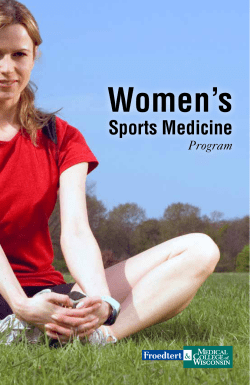
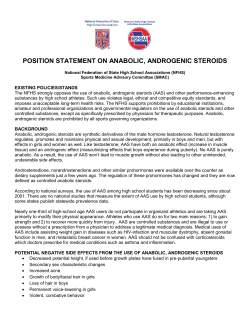


![” ⊙ Prohibited Substances [1] Anabolic-Androgenic Steroids](http://cdn1.abcdocz.com/store/data/000006330_2-6488874179c020189ebf4ca4aba01440-250x500.png)
